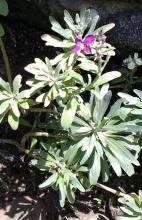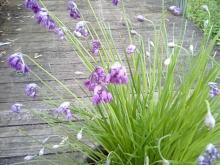Plant Identification
post an unknown plant and see if others can provide a name
Nevada wildlfower
Kudos to Lori for her identification of Cycladenia humilis! Encouraged by that, I am posting another stumper.
Found in open desertish environment, east of Ely NV, May 1990. Several knowledgeable persons have failed to come up with any
suggestion. I will not mention my own tentative family associations, as I do not want to maybe falsely predispose people looking at this.
This was the only time and place I had come across this plant.
ciao,
Andrew
Grassy-leaved, wiry-stemmed tufted plant
This was one of the last photos I took of any plant in my Pennsylvania garden, before moving to Texas. Looks to be in caryophyllaceae, but it doesn't match any of the plants I had on record as growing in my rock garden - it may have been grown from mislabeled seed. I had various dianthus and saponarias in that general area. Seed almost certainly came from NARGS exchange, since that's where the bulk of my rock garden plants came from. Any ideas?
extremely dwarf Hemerocallis, late bloomer
I would love to share seed from this if I knew exactly what it was. I am pretty sure I obtained a clump of seedlings at a local NARGS meeting, but my notes are failing me. It blooms late, usually Aug-Sept. This year it is warm enough that it is reblooming Oct 26! The plants are over 5 years old, so this seems to be the final size. The color is a clear lemon, the leaves are very narrow. My best guesses from species lists are either much too large or bloom much earlier.
Unknown plant in Bugaboo Provincial Park, B.C.
Can anyone identify this plant? Photo was taken on August 4, 2016 in or close to Bugaboo Provincial Park in British Columbia, Canada. Location: above tree line, 7,000 to 8,000 feet.
My own tentative guess was some species of Chaenactis.
Alex Maksymowicz
Fabaceae in the Bighorns
This plant was fairly common at high altitude in the Bighorn Range of Wyoming last June. The prominent keel makes one think of Oxytropis but maybe it is an Astragalus. Any ideas?
Linda Vaxvick, Calgary


